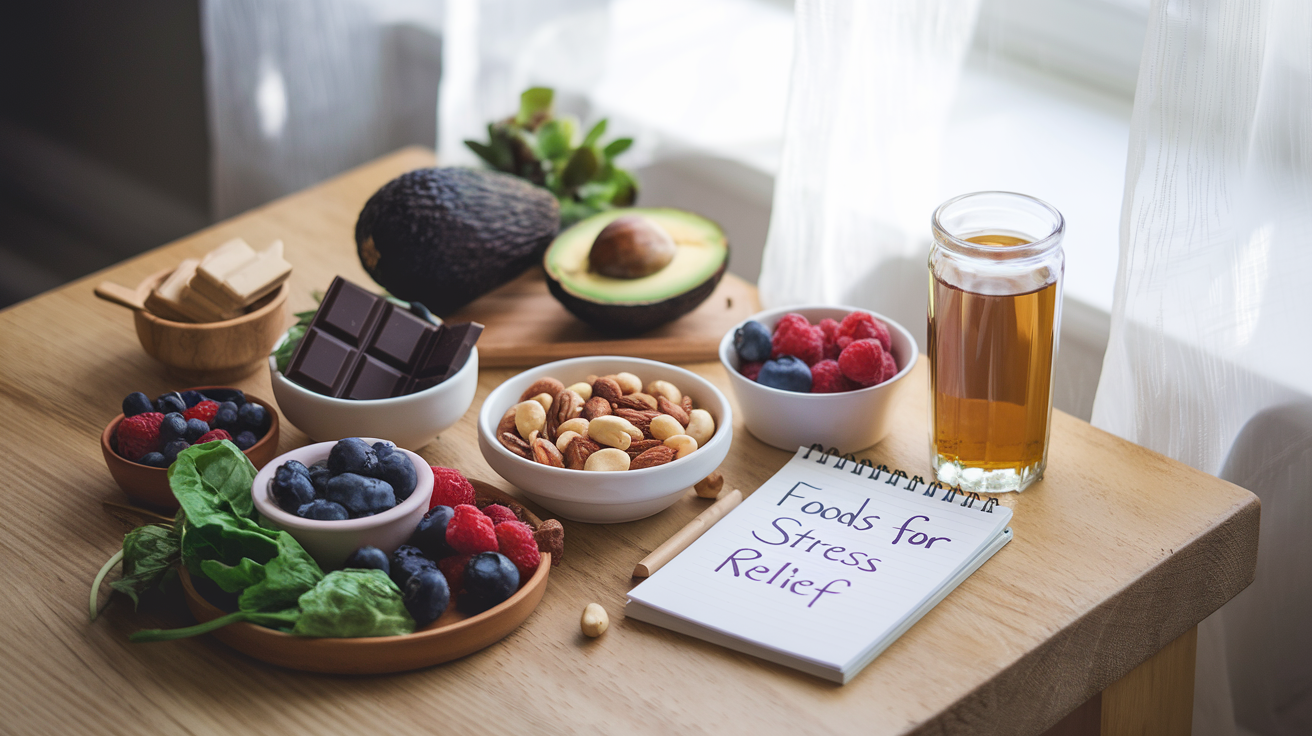
Did you know that 77% of Americans regularly experience physical symptoms caused by stress? That’s not just a number—that’s most of us lying awake at 3 AM with our minds racing.
I’ve spent years helping busy professionals manage stress without quitting their jobs or moving to a monastery. The healthy habits for managing stress I’m about to share actually work in real life—not just in perfect-world scenarios.
You don’t need to overhaul your entire existence. Small, strategic changes create the biggest impact when your stress levels are through the roof.
But here’s what most stress management articles get completely wrong: relaxation isn’t always the answer. In fact, sometimes it’s the worst thing you could do…
Regular Exercise: Your Body’s Natural Stress Reliever
When stress hits, your body craves movement. It’s not just about getting fit – exercise is literally your built-in stress management system. And the best part? You don’t need fancy equipment or hours at the gym to reap the benefits.
Quick 15-minute workouts that fit any schedule
Got 15 minutes? That’s all you need to kick stress to the curb. Try these quick hits:
- A 5-minute cardio warm-up, 5 minutes of bodyweight exercises (squats, push-ups, lunges), and 5 minutes of stretching
- HIIT sessions: 30 seconds on, 30 seconds rest for 15 minutes
- Dance breaks to your favorite songs (nobody’s watching!)
The magic happens when you make it non-negotiable. Block out 15 minutes on your calendar and treat it like an important meeting – with yourself.
How walking reduces cortisol levels
Walking might seem too simple to be effective, but science disagrees. A 20-minute walk can drop your cortisol (that pesky stress hormone) by up to 10%.
Walking outdoors doubles the benefit. The combination of gentle movement and nature exposure creates a one-two punch against stress. The rhythm of walking also creates a meditation-like state, giving your brain the reset it desperately needs.
Yoga poses specifically designed for stress relief
These three poses will melt tension away in minutes:
- Child’s pose: Knees wide, big toes touching, arms extended forward
- Cat-cow flow: Alternate between arching and rounding your spine on hands and knees
- Legs up the wall: Exactly what it sounds like – an instant nervous system reset
The beauty of yoga for stress is that it combines movement with breath awareness, essentially giving your nervous system a soft reboot.
The connection between physical activity and mental clarity
Ever notice how a workout clears your head? That’s not coincidence. Exercise floods your brain with BDNF (brain-derived neurotrophic factor) – basically Miracle-Gro for your brain cells.
Regular movement also improves sleep quality, and we all know how a bad night’s sleep affects our stress levels. The exercise-sleep-stress connection creates either a vicious cycle or a virtuous one, depending on your choices.
The ultimate stress-busting workout combines cardio, strength, and flexibility – but honestly, the best exercise is the one you’ll actually do. Find movement that brings you joy, and stress won’t stand a chance.
Nutrition Strategies for Stress Management

Foods that naturally combat anxiety
When stress hits, your pantry can be your best ally. Certain foods pack powerful compounds that actively calm your nervous system.
Dark chocolate isn’t just delicious—it’s packed with antioxidants that reduce stress hormones. Just a small square (70% cocoa or higher) can do wonders for your mood.
Fatty fish like salmon, mackerel, and sardines contain omega-3s that reduce inflammation and anxiety. Try eating fish twice weekly for noticeable benefits.
Avocados might seem trendy, but they’re legitimate stress-fighters. Their B vitamins help produce neurotransmitters like serotonin—your brain’s natural mood lifter.
Chamomile, green tea, and turmeric tea all contain compounds that physically relax your muscles and mind. Sip them throughout the day when tension creeps in.
Nuts and seeds aren’t just convenient snacks—they’re anxiety-busting powerhouses. Walnuts, almonds, and pumpkin seeds deliver zinc, magnesium and healthy fats that support brain health.
Fermented foods like yogurt, kimchi, and sauerkraut improve gut health, which directly influences your mental state through the gut-brain connection.
The importance of staying hydrated
Dehydration makes everything worse—especially stress. When you’re dehydrated, your body produces more cortisol, the primary stress hormone.
Most people don’t realize they’re walking around mildly dehydrated all day. Even slight dehydration (1-2%) impairs cognitive function and amplifies anxiety symptoms.
Water isn’t just filling space in your body—it’s actively transporting nutrients to your brain and removing toxins that contribute to stress.
Keep water within arm’s reach all day. Your brain often confuses thirst with hunger or anxiety, so taking a drink might resolve what you thought was stress.
If plain water bores you, try infusing it with cucumber, berries, or citrus. The subtle flavor makes hydration more appealing.
A good hydration rule: drink half your body weight in ounces daily. A 160-pound person would aim for 80 ounces of water.
Supplements that support your nervous system
While food comes first, quality supplements can fill nutritional gaps that might be contributing to your stress levels.
Magnesium is probably the most important anti-stress mineral, yet about 75% of Americans don’t get enough. It calms your nervous system, improves sleep, and relaxes tense muscles. Magnesium glycinate is the most absorbable form.
L-theanine, found naturally in green tea, promotes relaxation without drowsiness. It works beautifully for taking the edge off during high-stress workdays.
Ashwagandha isn’t just a trendy supplement—it’s an adaptogen with serious research behind it. It helps your body resist physical and mental stressors while balancing hormones.
B-complex vitamins support your adrenal glands, which get depleted during chronic stress. They’re especially important if you drink alcohol regularly.
Omega-3 supplements work when you can’t get enough fatty fish in your diet. Look for ones with higher EPA than DHA for mental health benefits.
Meal planning to avoid stress-inducing food choices
The 4pm hunger crash is when most stress eating happens. Planning prevents this entirely.
Batch cooking on Sundays takes just 1-2 hours but saves you from making dozens of food decisions when you’re already mentally drained.
The most successful stress-management meal plans include protein at every meal. Protein stabilizes blood sugar, preventing the irritability that comes with crashes.
Keep emergency snacks in strategic locations—your desk drawer, car, and bag. Good options include nuts, seed crackers, and jerky that won’t spike your blood sugar.
Eating at regular intervals prevents the hangry monster from emerging. Set alarms if needed to remind yourself to fuel up before you crash.
The “cook once, eat twice” strategy works wonders for busy people. When making dinner, automatically double the recipe for tomorrow’s lunch.
How sugar affects your stress levels
Sugar isn’t just bad for your waistline—it’s arguably the most stress-inducing food substance you can consume.
When you eat sugar, you get a momentary calm as dopamine floods your brain. But the crash that follows within hours makes anxiety significantly worse.
Your blood sugar and stress hormones are intimately connected. Every blood sugar spike triggers a cortisol release, creating a vicious cycle of stress.
Hidden sugars in “healthy” foods like granola, yogurt, and energy bars can sabotage your stress management efforts without you realizing it.
Replace sugar cravings with healthy fats and protein. An avocado with salt or a handful of macadamia nuts can satisfy what feels like a sugar craving.
The sugar-stress cycle takes about 10 days to break. Push through those initial tough days, and you’ll experience dramatically more stable moods and energy.
Quality Sleep: The Foundation of Stress Resilience
Creating the ideal sleep environment
Your bedroom should be your sanctuary – not a multipurpose space where you work, scroll social media, and occasionally sleep. Most people don’t realize how much their environment impacts sleep quality.
Start with darkness. Complete darkness. Those little LED lights from electronics? Cover them. That streetlight peeking through your curtains? Get blackout curtains. Your brain produces melatonin in darkness, and even small amounts of light can disrupt this process.
Temperature matters too. The sweet spot? Around 65-68°F (18-20°C). Your body naturally cools down to fall asleep, so a cooler room helps this process along.
Noise is another sleep killer. If you live somewhere noisy, consider a white noise machine or fan to create consistent background sound that masks disturbances.
And your bed itself? Don’t cheap out here. You spend a third of your life on your mattress. Make sure it supports your body properly and feels comfortable for your sleep position.
Pre-bedtime routines that signal your brain to relax
The hour before bed sets the stage for how quickly you’ll fall asleep. Your brain needs clear signals that it’s time to wind down.
Ditch the screens. I know, I know – everyone says this. But the blue light from phones and tablets really does suppress melatonin. Try to put devices away at least 30 minutes before bed. Better yet, make it an hour.
Instead, create a consistent routine your brain will recognize as “sleep is coming”:
- Take a warm shower or bath (the temperature drop afterward mimics natural sleep onset)
- Read something physical (not a thriller that keeps you up!)
- Do gentle stretching or yoga
- Practice deep breathing or meditation
- Write in a journal to dump out lingering thoughts
The consistency matters more than the specific activities. Your brain loves patterns and will start producing sleep hormones on cue once established.
How to break the cycle of stress-induced insomnia
The cruel irony of stress-induced insomnia? The more you worry about not sleeping, the harder it becomes to sleep. Breaking this cycle requires addressing both the stress and the sleep problems.
First, stop watching the clock. Turn it away from you. Clock-watching just creates anxiety about how little sleep you’re getting.
If you can’t fall asleep within 20 minutes, get up. Don’t lie there ruminating. Go to another room, dim the lights, and do something boring until you feel sleepy again. The goal is to rebuild the association between your bed and actual sleep.
Try these specific techniques for stress-induced insomnia:
- Progressive muscle relaxation: Tense and then release each muscle group from toes to head
- Worry journaling before bed to empty your mind
- Guided sleep meditations that talk you through relaxation
- Cognitive reframing of catastrophic thoughts about lack of sleep
Remember that one bad night won’t ruin you. Our bodies are resilient. This perspective alone can reduce the anxiety that perpetuates insomnia.
Mindfulness Practices for Daily Calm
5-minute meditation techniques for beginners
Ever tried meditation but felt like you’re doing it wrong? Or maybe you think you need an hour of free time to even start? Nope. Five minutes is all it takes.
Here’s a super simple technique: Just sit comfortably, close your eyes, and focus on your breath. When your mind wanders (and it will—that’s normal!), gently bring your attention back to breathing. Do this for five minutes. That’s it!
Another beginner-friendly approach? Count your breaths from one to ten, then start over. Made it to ten without your grocery list popping into your head? Congrats! That’s meditation success.
Body scan meditations work wonders too. Start at your toes and mentally move up, noticing sensations in each part of your body without judgment.
Stuck in traffic? Try this: Focus fully on the sensation of your hands on the steering wheel for five breaths. Instant calm.
Breathing exercises you can do anywhere
Breathing is your secret weapon against stress, and nobody around you even needs to know you’re doing it.
The 4-7-8 technique is a game-changer: Inhale through your nose for 4 counts, hold for 7, exhale through your mouth for 8. Repeat four times. This literally resets your nervous system.
Box breathing works too—especially during tense meetings. Inhale for 4, hold for 4, exhale for 4, hold for 4. Visualize tracing a square as you do it.
Feeling anxious in public? Try belly breathing: Place one hand on your stomach, inhale deeply through your nose so your belly pushes your hand out, then exhale slowly through pursed lips. Three rounds can calm racing thoughts.
The beauty? You can do these while standing in line, sitting at your desk, or waiting for your coffee order. No special equipment or privacy needed.
Mindful walking as a stress-reduction strategy
Walking isn’t just transportation—it’s meditation in motion.
Next time you’re walking, try this: Notice how your feet feel touching the ground. Feel the weight shift from heel to toe. Pay attention to the rhythm of your steps.
Then expand your awareness outward. What sounds do you hear? Notice colors, textures, and shapes around you without labeling or judging them.
Many people find mindful walking easier than seated meditation because the movement gives your body something to do while your mind focuses.
Start small—even a mindful walk from your car to the office counts. The sweet spot? A 10-minute mindful stroll in a natural setting like a park or garden.
Walking meetings are another brilliant hack—movement naturally reduces stress hormones, and being outside adds an extra mindfulness boost.
Apps and resources for guided relaxation
The digital world actually offers some amazing tools for finding calm (ironic, right?).
Headspace and Calm lead the pack with guided meditations for every situation—from “I’m freaking out before a presentation” to “I need help falling asleep.” Their free versions give you plenty to start with.
Insight Timer is a hidden gem with over 100,000 free meditations from teachers worldwide. Perfect if you want variety without a subscription.
For those who prefer more structure, the Ten Percent Happier app breaks mindfulness down into practical, bite-sized sessions that even skeptics find helpful.
YouTube is also packed with free guided meditations—The Honest Guys and Yoga with Adriene offer quality content that won’t cost you a dime.
No time to meditate? Try Breathe—a simple app that guides you through quick breathing exercises with gentle vibrations and visual cues. Three minutes on this app can transform your mental state.
Setting Boundaries to Protect Your Mental Health
How to say “no” without guilt
Ever noticed how hard it is to say those two tiny letters: N-O?
You’re not alone. Most of us struggle with setting boundaries because we’re afraid of disappointing others or seeming selfish. But here’s the truth: saying yes when you want to say no is a fast track to burnout.
The secret to guilt-free boundary setting? Honesty delivered with kindness. Instead of making excuses, try: “I appreciate you thinking of me, but I don’t have the bandwidth right now.”
Remember, a no to someone else is a yes to yourself. And that’s not selfish—it’s self-preservation.
Creating a work-life balance that works for you
Work-life balance isn’t one-size-fits-all. What works for your colleague might be your personal nightmare.
Start by identifying your non-negotiables. Maybe it’s dinner with family, your morning run, or weekend tech-free time. Protect these fiercely.
Next, audit where your time actually goes. Many of us think we’re working 8 hours when reality shows 10+. Track your time for a week—the results might shock you.
Then set clear boundaries like:
- Dedicated work hours
- No-email times
- Physical separation between work and living spaces
The magic happens when you stop chasing “perfect balance” and create rhythms that honor both your work commitments and personal needs.
Digital detoxing strategies
Our devices have become permanent appendages. The average person checks their phone 96 times daily—that’s once every 10 minutes!
Digital overwhelm is real, but you don’t need to move to a cabin in the woods to recover. Try these practical detox strategies:
- Create tech-free zones in your home (especially bedrooms)
- Use “airplane mode” for focused work or family time
- Delete social apps from your phone for weekends
- Turn off non-essential notifications
- Schedule specific times to check email rather than constant monitoring
Start small—even a 30-minute daily break from screens can reset your nervous system and improve mental clarity.
The goal isn’t eliminating technology but becoming its master rather than its servant.
Time Management Techniques That Reduce Overwhelm
The Pomodoro Method for Enhanced Productivity
Ever noticed how your stress levels skyrocket when you’re staring at an endless to-do list? The Pomodoro Technique cuts through that overwhelm like nothing else. Here’s the simple magic: work intensely for 25 minutes, then take a 5-minute break. After four cycles, reward yourself with a longer 15-30 minute break.
Why does this work so well? Your brain thrives on these focused sprints. Instead of the dreaded “I have to work on this all day” feeling, you’re just committing to 25 minutes. Anyone can do anything for 25 minutes!
Try this today: Set a timer, silence notifications, and dive deep into one task. When the timer rings, stand up, stretch, grab some water, then go again. Many people find they accomplish more in four focused Pomodoros than in an entire unfocused day.
Priority Mapping to Focus on What Truly Matters
Not all tasks deserve your attention equally. Priority mapping helps you identify what actually moves the needle versus what just keeps you busy.
Start with a brain dump of everything on your plate. Then sort each item into one of four categories:
| Urgency | Importance | Action |
|---|---|---|
| High | High | Do immediately |
| High | Low | Schedule or delegate |
| Low | High | Plan time for these |
| Low | Low | Eliminate if possible |
This simple matrix prevents the common trap of handling urgent-but-unimportant tasks while neglecting the important-but-not-urgent work that often brings the greatest rewards.
The game-changer here? Learning to say no to the bottom-right quadrant. Those tasks drain your energy without meaningful results.
Batching Similar Tasks to Reduce Decision Fatigue
Did you know your brain gets tired from making decisions? Each choice you make throughout the day—even tiny ones—drains your mental battery.
Batching is your secret weapon against this drain. Group similar tasks together and tackle them in one go:
- Set aside specific hours for emails and messages
- Process all bills and financial tasks on one designated day
- Make all your phone calls back-to-back
- Prepare meals for the week in one cooking session
The efficiency gains are massive. You’ll slip into a flow state more easily when doing similar work, and you’ll eliminate the mental startup cost of switching contexts repeatedly.
Planning Ahead to Minimize Morning Chaos
Morning stress sets the tone for your entire day. The solution? Handle tomorrow’s decisions today.
Before bed each night:
- Lay out your clothes
- Pack your lunch
- Review your calendar and prepare any materials needed
- Write down your top three priorities for the day
- Place everything you need by the door
This evening routine might take 15 minutes, but it saves double that time in the morning—when you’re likely more rushed and less focused.
The real benefit isn’t just time saved; it’s starting your day with a sense of control rather than chaos. When your morning unfolds smoothly, you carry that calm energy throughout the day.
Social Connection as Stress Relief
Building a supportive network
When stress hits hard, who do you call? That group text that always makes you laugh? Your mom who’s been through it all? The friend who just gets it?
These people aren’t just contacts in your phone – they’re your stress-busting team. Having a solid crew of supporters isn’t a luxury; it’s as essential as your morning coffee.
Start small. Identify 3-5 people who lift you up instead of drain your battery. Quality trumps quantity every time. Then nurture these connections like plants – regular attention, authentic conversations, and mutual support make them thrive.
Join groups aligned with your interests too. Book clubs, running groups, volunteer organizations – these create ready-made communities where bonds form naturally around shared passions.
And don’t forget digital connections. While nothing beats in-person hangouts, online communities can provide specialized support, especially when local options are limited.
The healing power of meaningful conversation
There’s small talk, and then there’s real talk. Guess which one actually helps with stress?
Deep, meaningful conversations create a special kind of magic. When you share what’s truly weighing on you, something shifts. The burden feels lighter – not because it disappeared, but because it’s now shared.
This isn’t about constant venting (that can actually increase stress). It’s about authentic exchanges where you feel truly seen and heard.
Good conversations include:
- Open-ended questions beyond “how are you?”
- Active listening without planning your response
- Vulnerability from both sides
- Space for silence and reflection
- Zero judgment
Your brain literally releases oxytocin during these connections, counteracting stress hormones that have been building up.
When and how to ask for help
We’ve all been there – drowning in stress but still saying “I’m fine” when asked. Breaking this pattern might be the healthiest habit you develop all year.
Asking for help isn’t admitting defeat. It’s actually strategic stress management. But timing and approach matter.
Recognize these signs that it’s time to reach out:
- Your usual coping strategies aren’t working
- You’re avoiding people or activities you usually enjoy
- Your stress affects sleep, appetite, or concentration
- You feel overwhelmed by everyday tasks
- You’re using unhealthy coping mechanisms more frequently
When you do ask, be specific about what you need. “Can you help me brainstorm solutions?” works better than a vague “I’m stressed.” And remember to accept help in the form it’s offered, even if it’s not exactly what you envisioned.
The strongest people aren’t those who never need help – they’re the ones who know when and how to ask for it.
Nature’s Impact on Stress Reduction
The Science Behind Forest Bathing
The Japanese call it “shinrin-yoku” – literally, forest bathing. And it’s not just some trendy wellness fad. Real science backs this up.
When you immerse yourself in nature, your body responds in measurable ways. Your cortisol levels (that’s your stress hormone) drop significantly. Your blood pressure comes down. Your heart rate stabilizes.
But why? Trees release compounds called phytoncides – their natural oils that protect them from insects and bacteria. When we breathe these in, our bodies respond by increasing our natural killer (NK) cells, boosting our immune system and reducing stress.
A study from Nippon Medical School found that just 3 days in a forest environment increased NK cell activity by 50%, with effects lasting more than 30 days!
Forest bathing isn’t complicated:
- Find a forested area
- Turn off your phone
- Walk slowly, without a destination
- Breathe deeply
- Use all five senses
Creating a Stress-Reducing Environment at Home
Can’t make it to the forest? Bring nature’s calming effects home instead.
House plants aren’t just pretty – they’re powerful stress busters. NASA research shows they remove toxins from the air while increasing humidity and oxygen levels.
Try these easy nature-inspired tweaks:
- Place plants in your main living spaces – snake plants and peace lilies are nearly impossible to kill
- Open windows for fresh air and natural sounds
- Use natural materials like wood, stone, and cotton
- Incorporate nature sounds (rainfall, forest sounds) when you need to focus
- Create a mini indoor garden with herbs in your kitchen
The color green itself has been shown to reduce stress and promote feelings of calm. Even looking at nature photographs can lower your heart rate.
How Sunlight Exposure Affects Your Mood
Feeling down? You might just need more sunshine.
Sunlight triggers your brain to release serotonin – that feel-good chemical that boosts mood and helps you feel calm and focused. Without enough sun exposure, your serotonin levels can dip, sometimes leading to seasonal affective disorder.
Morning sunlight is particularly powerful. It resets your internal clock, helping you sleep better at night. Even 10-15 minutes of morning light can make a huge difference.
Beyond mood, sunlight helps your body produce vitamin D, which reduces inflammation, improves immune function, and supports bone health.
But remember:
- Aim for 10-30 minutes of direct sunlight daily
- Morning sun (before 10am) gives benefits with lower UV risk
- If you’re stuck indoors, sit near windows or use a light therapy box
Simple Outdoor Activities With Maximum Benefits
You don’t need to climb mountains or run marathons to get nature’s anti-stress benefits. Simple activities often work best:
-
Mindful walking – Find a park or trail and walk slowly, paying attention to everything around you. Notice colors, textures, sounds, and smells.
-
Gardening – Digging in the dirt isn’t just productive – it exposes you to soil microbes that actually increase serotonin production. Even tending to a small herb garden counts.
-
Outdoor meditation – Find a comfortable spot, sit, and focus on natural sounds and sensations. Even 5 minutes can reset your stress levels.
-
Cloud watching – Lie on your back and watch clouds drift by. It’s practically impossible to stay stressed while cloud-gazing.
-
Eat outside – Take your lunch to a park bench instead of eating at your desk. The combination of fresh air, natural light, and stepping away from work creates a powerful stress-reducing effect.
Creative Outlets for Emotional Processing
Journaling techniques to release anxious thoughts
Feeling wound up so tight that your brain’s just a mess of worries? Grab a pen. Seriously.
Journaling isn’t just for teenagers with locks on their diaries. It’s a scientifically-backed way to dump your anxieties onto paper instead of letting them bounce around your head all day.
Try this: Set a timer for 10 minutes and just write. Don’t edit, don’t judge what comes out. This is called “stream of consciousness” writing, and it’s like a mental detox.
Or go for the “worry dump” approach – literally list everything stressing you out, no matter how small. Seeing those worries in black and white often makes them less intimidating.
My personal favorite? The “letter you’ll never send.” Write to your boss, your ex, or even to stress itself. Say everything you wish you could say without any real-world consequences.
Art therapy you can do without artistic skill
“But I can’t even draw a stick figure!” I hear you. Good news: art therapy isn’t about creating masterpieces.
Coloring books for adults became popular for a reason. The repetitive motion and focus required to stay inside those lines is basically meditation with prettier results.
Try making a stress collage. Flip through magazines, cut out images or words that represent your feelings, and glue them together. No drawing skills needed, but you’ll be surprised how revealing it can be about what’s really bothering you.
Even simple doodling counts. Next time you’re on a phone call that’s raising your blood pressure, grab a pencil and just make patterns. Circles, squares, squiggles – whatever feels good. Your hand stays busy while your mind gets a break.
Music’s role in emotional regulation
Music isn’t just background noise – it’s emotional chemistry for your brain.
When you’re stressed, your body’s rhythms are out of whack. Your breathing’s shallow, your heart’s racing. But put on the right song, and something magical happens – your body starts matching the beat. This is called “entrainment,” and it’s why slow songs can physically calm you down.
Creating playlists for different moods gives you emotional first aid at your fingertips. Make one for when you need to calm down, another for when you need energy, and one more for when you need to have a good cry.
Don’t just listen passively – try drumming on your desk, singing in your car, or dancing in your kitchen. These active forms of music engagement release tension you’re holding in your body.
And if you’re really adventurous? Try sound healing. Those singing bowls and tuning forks aren’t just hipster decorations – they create vibrations that can help reset your nervous system when it’s in fight-or-flight mode.
Professional Support: When to Seek Expert Help
A. Signs that stress is becoming chronic or unhealthy
We all deal with stress, but sometimes it crosses a line from normal to problematic. Your body will tell you when stress has overstayed its welcome.
Physical red flags include constant headaches, that knot in your stomach that never leaves, or waking up tired no matter how much you sleep. Maybe you’re catching every cold that passes through your office, or your blood pressure’s climbing despite your healthy diet.
Mentally, you might notice you can’t focus on anything longer than a TikTok video. Or perhaps you’re snapping at your kids over spilled milk when normally you’d laugh it off.
Watch for these warning signs:
- Persistent sleep problems (either can’t sleep or sleeping too much)
- Significant weight changes without trying
- Feeling overwhelmed by tasks you used to handle easily
- Increasing reliance on alcohol or other substances to cope
- Withdrawing from friends and activities you once enjoyed
- Constant worry that doesn’t seem to have an off switch
Trust your gut. If you’re thinking “something’s not right here,” listen to that voice.
B. Types of therapy specifically for stress management
Not all therapy approaches work the same for stress. Here’s what actually helps when you’re overwhelmed:
Cognitive Behavioral Therapy (CBT) tackles those doom-and-gloom thought patterns head-on. It’s like having someone point out when your brain is lying to you about how terrible everything is.
Mindfulness-Based Stress Reduction (MBSR) teaches you to stay in the present moment instead of spiraling about tomorrow’s problems or yesterday’s mistakes. Perfect for overthinkers.
Acceptance and Commitment Therapy (ACT) helps you stop fighting your stress (which, ironically, creates more stress) and instead focus on moving toward what matters to you.
Some therapists also offer biofeedback – where you literally see how your body responds to stress in real-time and learn to control those responses. Pretty cool, right?
Group therapy can be surprisingly powerful. Nothing beats hearing “me too” from others who get what you’re going through.
C. How to find the right professional for your needs
Finding a therapist shouldn’t be another source of stress. Start with what’s practical – who takes your insurance, has availability when you need it, and offers sessions in a format that works for you (in-person, video, etc.).
Don’t settle for the first name you find. Most therapists offer free consultation calls – use these to gauge if you click. The connection matters more than fancy credentials.
Ask potential therapists direct questions:
- “What’s your approach to stress management specifically?”
- “How many clients have you helped with similar issues?”
- “What would our first few sessions look like?”
Don’t know where to start? Try:
- Psychology Today’s therapist directory
- Your primary care doctor for referrals
- Employee assistance programs through work
- Community mental health centers for affordable options
Remember that finding the right fit might take a couple tries. That’s normal, not a failure.
D. Combining professional guidance with self-care practices
Therapy works best when you’re putting in work between sessions too. Think of your therapist as a coach – they guide your practice, but you still need to run the drills.
Create a personalized stress toolkit combining professional techniques with daily habits:
Morning: Five-minute meditation your therapist taught you + journaling exercise
Workday: Breathing technique during stressful meetings + lunchtime walk
Evening: Guided relaxation recording + screen-free wind-down
Track what works. Maybe that progressive muscle relaxation your therapist suggested helps before big presentations, but meditation works better for ongoing stress.
Be honest with your therapist about what’s realistic for you. No time for 30-minute meditations? Say so! They can suggest shorter practices that fit your life.
The best approach blends professional insights with what you know about yourself. Your therapist brings expertise about stress management, but you’re the expert on you.
Adopting healthy stress management habits isn’t just about feeling better in the moment—it’s about creating a sustainable lifestyle that builds resilience against life’s inevitable challenges. Whether it’s through regular exercise, mindful nutrition, quality sleep, or practicing daily mindfulness, each strategy offers unique benefits that combine to form a powerful defense against chronic stress. Setting boundaries, managing time effectively, and maintaining social connections further strengthen your mental health foundation, while nature exposure and creative outlets provide essential emotional release.
Remember that managing stress is a personal journey, and what works best will vary from person to person. Start by incorporating just one or two of these habits into your routine and gradually build upon your success. If stress becomes overwhelming despite your best efforts, don’t hesitate to reach out to a mental health professional—seeking support is itself a sign of strength and self-awareness. Your well-being deserves attention and care, today and every day.














No Comments